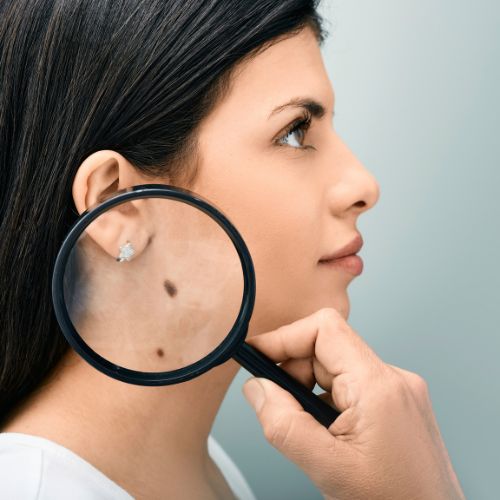Noticing a small growth on your skin can be unsettling. You might ask yourself: How long has that been there? Then comes the bigger question: Is it a mole, a skin tag, or something else entirely?
Understanding the difference between moles and skin tags is essential—not just for peace of mind, but also for your skin’s health.
What Is a Skin Tag?
A skin tag is a harmless (benign) growth made of normal skin, blood vessels, fat, and sometimes fibrous tissue. They typically protrude from the skin’s surface and are often attached by a thin stalk or pedicle.
These growths are usually the same color as the surrounding skin, but in some cases, they can be slightly darker. This darker tone sometimes makes them resemble moles at first glance.
Why Do Skin Tags Form?
The exact cause isn’t fully understood, but research and dermatology experience suggest:
- Genetic tendency — They often run in families.
- Age factor — They become more common with age.
- Metabolic conditions — Links exist with prediabetes, type 2 diabetes, obesity, and PCOS.
- Friction — While not a direct cause, areas prone to rubbing—like skin folds—are more likely to develop tags or have existing ones grow larger.
Common locations:
- Neck
- Underarms
- Groin
- Under the breasts
- Eyelids
- Around genitals
Tip: If skin tags keep appearing or are increasing in size, a visit to a qualified dermatologist in Roorkee can help identify any underlying triggers.
What Is a Mole?
A mole is a cluster of melanocytes—the cells that produce pigment for skin, hair, and eyes. Moles can be caused by genetics or exposure to ultraviolet (UV) radiation from the sun or tanning beds.
They usually appear darker than the surrounding skin—brown, black, or tan. However, dermal moles can be flesh-colored, which can make them look similar to skin tags.
Key Differences Between Skin Tags and Moles
FeatureSkin TagMoleColorSkin-colored or slightly darkerUsually darker (brown/black), sometimes flesh-coloredShapeSoft, protrudes on a stalkFlat or raised, wider baseLocationCommon in friction areasCan form anywhereRiskAlmost always harmlessSome may be precancerous or cancerous
Dermal moles are often firmer and broader at the base compared to skin tags. They also don’t dangle from a stalk-like structure.
Should You Be Concerned?
Skin tags are benign and pose no direct health risk. Moles are mostly harmless too—but some can be precancerous or cancerous, especially if they change in:
- Color
- Shape
- Size
- Texture
If you notice sudden changes, bleeding, or irregular borders, get the growth checked by a dermatologist immediately.
Professional Insight from Dr. Hera Tabassum
Dr. Hera Tabassum is one of the top dermatologists and skin care experts in Roorkee, Uttarakhand. Known for her expertise in diagnosing and treating a variety of skin, hair, and nail disorders—including acne, fungal infections, eczema, hair loss, warts, and vitiligo—she provides both medical accuracy and patient comfort in her consultations.
Her clinic also offers advanced treatments such as age spot removal and aesthetic skin procedures, making it a trusted choice for comprehensive dermatological care.
Skin Tag Removal: Safe Options
While skin tags don’t require removal for medical reasons, people often choose to remove them for comfort or cosmetic purposes. Removal methods include:
- Cryotherapy (freezing)
- Electrocautery (burning)
- Surgical excision (cutting)
Important: Avoid home removal. DIY methods can cause pain, bleeding, infection, or incomplete removal. Over-the-counter products and remedies like apple cider vinegar are not recommended—they often cause irritation and can worsen the problem.
How to Protect Your Skin
- Monitor skin changes monthly.
- Wear sunscreen daily to reduce mole development risk.
- Maintain healthy weight to reduce friction-related skin tag growth.
- Consult a dermatologist annually for a skin check-up.
FAQs
1. Can a mole look like a skin tag? Yes—dermal moles can be flesh-colored and raised, making them resemble skin tags.
2. Are skin tags contagious? No, skin tags are not caused by infections and cannot be passed to others.
3. When should I see a doctor about a mole? If a mole changes in color, size, shape, or starts bleeding, seek medical attention immediately.
Bottom line: Skin tags and moles may appear similar at times, but their causes, risks, and management differ. If unsure, a professional skin evaluation is always the safest route.

